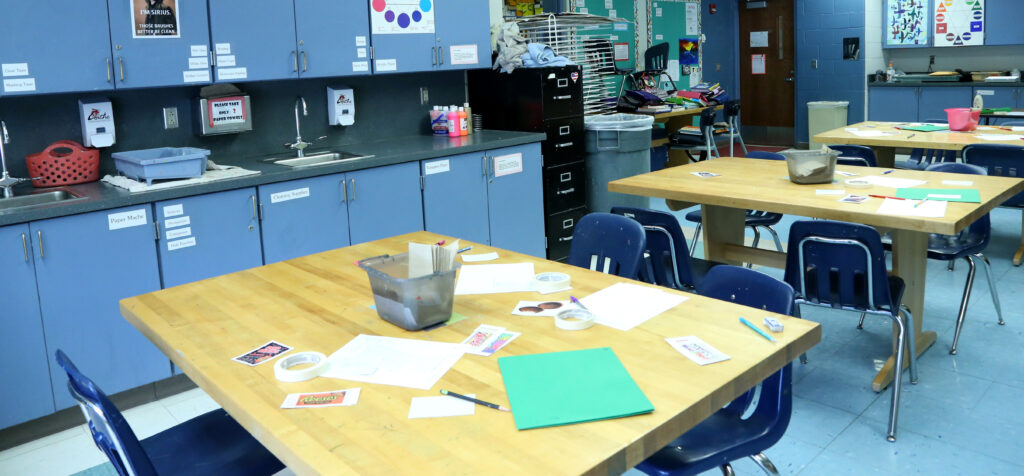For many new art teachers, the question, “Does this ever get any easier?” comes up a lot. Between late nights spent at school and weekends spent lesson planning, grading, and brainstorming ways to make your students behave in a civilized manner, being an art teacher can be HARD. Yet, there comes a time in every art teacher’s career where things just start to “click.” You find yourself staying late less often or having Saturday free to go to the art museum for fun. Your classroom management skills improve, and your routines and procedures get ironed out. I’m not saying that teaching art can ever be considered an easy job, but with some years under your belt, it definitely gets easier.

Here’s How I Hit My Stride in the Art Room and How You Can Too.
Looking back, I’ve always struggled to balance work and my personal life. For the first three years of my teaching career, I spent nearly every waking hour at school. I still had a full personal life, but school took up most of my time. However, this past summer, my personal life went through a whirlwind change when I became engaged and bought a house in the span of two weeks!
My professional life also changed dramatically. My position began requiring me to travel between three schools.
Even though new opportunities and challenges were coming at me from all directions, I felt good. You see, by this time, I had slowly but surely been hitting my stride in the art room. Over the past three years, I had worked tirelessly to make my classroom what I wanted it to be. My students and I had built meaningful relationships. My classroom routines and systems had undergone many revisions and were at a point where they were working well.

In addition, my attitude has played a big role. Letting go of some important things and adding new priorities has made a world of difference.
If You’re Still Looking to Hit Your Stride, Keep These 7 Things in Mind.
1. Give yourself time to grow, adjust, and experiment.
Teaching is a marathon, not a sprint. Things aren’t going to be perfect overnight. Allow yourself time to find what works for you.
2. Be kind and patient with yourself.
We are our own harshest critics. If you’re having trouble brainstorming ideas, find a colleague or instructional coach willing to support you.
3. Prioritize by doing less, well.
I streamlined my school to-do list into items that absolutely needed to be accomplished to get my job done effectively and be prepared for class every day…and left out the extras.
4. Learn how to say, “No.”
We hear this over and over, and it’s easier said than done. However, saying “no” is liberating, mentally and literally. You will have much more time if you choose to focus on things that are most important to you. You are not required to help a colleague make a decoration for their door.
5. If it works, don’t fix it.
New ideas, routines, and organizational strategies pop up all the time. But unless you need a change, don’t mess with a good thing!
6. Continue to learn.
Our jobs are continuously changing. Staying in the loop with new initiatives and strategies will help you adjust and adapt when necessary.
7. Revisit your “Why?” often.
Revisiting “Why” you chose to teach can help center your thinking as well as realign your tasks and goals to continue to meet your purpose. Doing so will allow frivolous tasks to naturally fall by the wayside.
It’s hard to say if hitting my stride was the result of force, fate, or a lot of hard work. It was probably a combination of all three. But, right now, I can say much of what my students and I have created together is working, in all my buildings. (Knock on wood!)
Of course, hitting your stride doesn’t mean you become stagnant or lose the desire to grow and learn. There will always be more effective ways to navigate every aspect of teaching art. What I have in place now may not work in ten years or ten months, but it works now, and I’m okay with it. In order to “Do Less, Well,” I strive to perfect what I have in place, versus what could be done. I will always push to be as effective as I can, but as #5 says: “If it works [now], don’t fix it.”
Note: This will be my last month as a regularly contributing writer with the Art of Education. This decision has been very bittersweet. AOE has been, and is, such a huge part of my life both professionally, and personally. I love interacting and sharing with the AOE readership and my AOE colleagues. As art teachers, we truly embody a special group of compassionate, innovative, and caring people. I have loved growing with you all as a professional with, and through, my writing for the Art of Ed.
As you read in the article, many of my life circumstances have changed, and I am excited to continue to grow professionally. I will continue to interact with you through AOE’s social media platforms, and may write an extra article here and there. Again, thank you all for being a part of my growth and confidence as an art educator. Through our support of each other, we are unstoppable!
Have you hit your stride? When did you know?
Are there days that just “click” – why do you think that is?
Magazine articles and podcasts are opinions of professional education contributors and do not necessarily represent the position of the Art of Education University (AOEU) or its academic offerings. Contributors use terms in the way they are most often talked about in the scope of their educational experiences.




